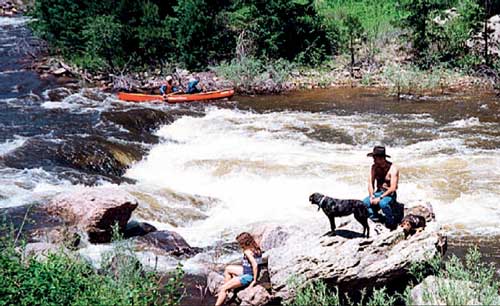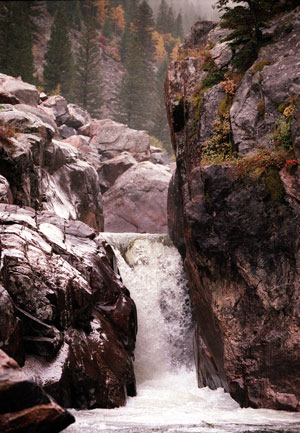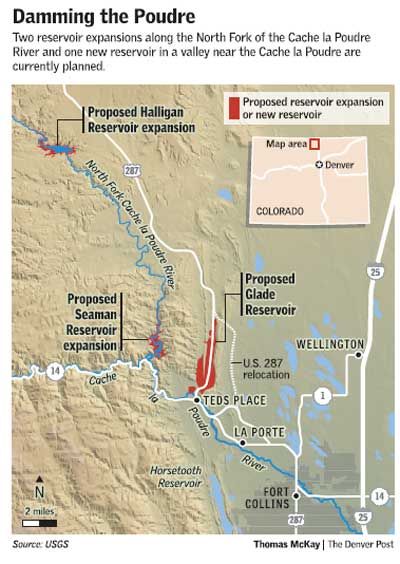|
|
A river runs through it Fort Collins has a river running through it. It's a fine river -- what's left of it -- and I see it almost every day as I walk or jog beside it near my house. On my outings, I also see wildlife, kayakers, fishermen, children playing and mothers pushing baby joggers. We are lucky here because the city, county, state, various land trusts and GOCO have spent hundreds of millions of dollars building a miles-long paved path beside this river and buying thousands of acres of recreational open space along the shores of its tributaries. When I first visited Fort Collins and thought of moving here, I walked down to the river -- the Cache la Poudre -- and dipped my feet into its cold, clear water. It was late spring, and the Poudre was boiling with rapids. For me, it was love at first sight. The Poudre smelled good, looked good, felt good. There's nothing like a beautiful river. There's nothing like clean, fast-moving water to put lady luck on your side. I said, "Let's give it try," and I moved my family to town. Our luck may soon run out. Recently, several Northern Colorado cities and water districts have proposed three huge dam-and-reservoir projects on the Cache la Poudre. These projects will cost about $750 million of taxpayer money and include the Glade, Seaman and Halligan reservoirs. Proponents of these projects claim they are needed to provide "drought protection" and to "meet the demands of new growth."
First, fiscal responsibility -- Economic analyses often show that
using water efficiently and ensuring comprehensive water conservation
can provide drought protection, meet growth's demands and not impact
"quality of life," all at a lower cost than building new
dams. (A section of Poudre Falls on the Cache La Poudre
River on Colorado 14, west of Fort Collins. (Special / Lucas J.
Gilman)) Second, environmental impacts -- Fort Collins and Larimer County rivers, natural areas and ecosystems will be profoundly impacted by these proposed new dams and reservoirs. Two geographic areas are of specific concern: the Laramie Foothills north of Fort Collins, including the North Fork of the Poudre River, and the main Poudre River corridor running through Fort Collins to Greeley, where it meets the South Platte. The Laramie Foothills project is a joint public-private conservation effort already conserving tens of thousands of acres, some of which will be flooded, and more of which will be degraded by massive water diversions out of the North Fork. All three reservoirs are smack-dab in the middle of these open-space efforts. Impacts to the Poudre River corridor would be equally devastating. This corridor includes a unique and much-loved ecosystem supporting wildlife and some rare and endangered species. Currently, more than two dozen diversions suck out at least 80 percent of the Poudre's flow before it reaches the South Platte. At the confluence, the Poudre is but a mere whisper of its former self; its once majestic and sparklingly clear flow has been transformed into an ephemeral, 15-foot-wide muddy and stinking ditch. These new dams will mean even less water for the river. Third, rapid population growth -- Most of the cities proposing to build these projects already have severe budget shortfalls yet are proposing huge debt loads for new dams. This is a formula for bankruptcy or for rapid population growth. The town of Erie, for example, proposes to go more than $60 million into debt for its share in Glade Reservoir, which is about $20,000 for every family in town. If a city has a budget crisis and it issues bonds to pay for new dams, then it must have fast growth to bring in new development fees and revenues in order to pay off those bonds. Already, a few cities have dropped out of the projects, worrying that they cannot grow fast enough to pay off the debt. In any case, growth intensifies, citizens foot the bill, and the river suffers. Fourth, economic sustainability -- Tens of thousands of citizens and tourists, including whitewater enthusiasts, fishermen, bicyclists, hikers and recreating families use the Poudre River and our natural areas every year. These people provide a large economic stimulus to northern Colorado's increasingly tourist-based economy. The huge, recent recreational open-space acquisitions lie exactly in the zone of impact. The Laramie Foothills project is a centerpiece of Colorado conservation, about which GOCO's executive director recently said, "This project is a great example of the landscape-scale protection the GOCO Board intended with its recent Legacy grants." Likewise, the Poudre River Trail as it runs through Fort Collins and Greeley is an urban recreational resource used by thousands of Larimer and Weld County citizens every day. *** Back when I first moved to Fort Collins, I was once stuck in a traffic jam atop the bridge on College Avenue that passes over the Poudre. My youngest daughter, then 3 years old, was fussing in the back seat, so I reached back to tickle her cheek. The Poudre caught my eye. It was June and the river was raging through town. I turned to my wife and said, "My God, that's a wild thing." Soon thereafter, we bought a house a few blocks from the Poudre, and ever since we've used the river and the trail almost every day. We walk, bike, swim, chase crawdads, watch beavers, canoe, skip rocks and build sand castles. My children are now old enough to go down to the river by themselves where they explore, climb trees and wade through swamps. So, as I began to learn more about the Poudre's imminent demise, I naturally became quite concerned. I talked to friends and their friends, and found out that many, many people were equally upset. Efforts to preserve the Poudre have been ongoing for decades -- the current dam proposals are mere ghosts of past proposals, now popping up in different side-canyons along its meandering tributaries. While the Poudre's flow may be diminishing, new efforts to preserve the river are strengthening rapidly. Over the past year, a large coalition of Colorado conservation groups has formed to address the threats. This coalition is not "anti-growth" and is certainly not naïve. We all recognize that demand for water is increasing along with population growth, and we recognize that a broad public dialogue is needed to ensure our area's economic and environmental sustainability. This coalition is working on several new ideas about water conservation and efficiency, entering into legal agreements with farmers to buy/lease/share water and retiming the flows in the Poudre for conservation purposes. The coalition is also interested in not just preserving the Poudre but in restoring historic streamflows. We are discussing conservation strategies that involve free-market incentives, and in connecting with a "water trust" -- an entity that would buy/lease/share water for conservation purposes. The water trust movement is just beginning in Colorado and is poised to be the next big thing, much like the land trust movement was 30 years ago. Ultimately, the coalition seeks a balanced approach to preserving
our unique quality of life. Here in northern Colorado, we have a
wonderful river with a curiously wonderful and unique name -- the
Cache la Poudre. The Poudre is a true wild thing in a world in which
wildness is increasingly rare. A balanced approach will make sure
Fort Collins always has a river running through it and that our
citizens are always lucky to enjoy it. Gary Wockner (www.garywockner. com) is a founding member of the
Sustainable Water Interest Group, a collation of Colorado conservation
organizations working to preserve the Poudre. He is a contributor
to and co-editor of the forthcoming book, Pulse of the River:
Celebrating Colorado's Endangered Cache la Poudre River (Johnson
Books, 2006). |


 These
new dams and reservoirs raise four important questions:
These
new dams and reservoirs raise four important questions: